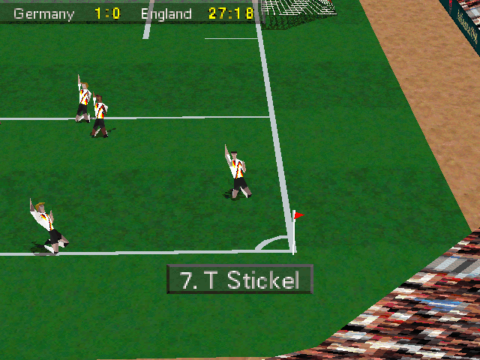
Olympic Soccer
Written by: Rik
Date posted: August 24, 2019
- Genre: Sport
- Developed by: Silicon Dreams
- Published by: U.S. Gold
- Year released: 1996
- Our score: 4
It might sound a little too on the nose in terms of period-appropriate references, but this is absolutely true: I bought my copy of Olympic Soccer from Woolworths in 1998, along with the Fatboy Slim single The Rockafeller Skank on cassette. As any long-term readers (if indeed they exist) will know, 90s Rik had a weakness for football games and seemed at one point to be on a quest to acquire as many of them as possible, in the misguided and forlorn hope that some low profile title might have slipped under the radar and actually prove to be a better and more enjoyable effort than the FIFAs and Actuas of the day. Hence, Olympic Soccer – probably not the first, nor the last, football game purchase of that particular year.
In a much more competitive marketplace than we have today, games fought to stand out either in terms of technological innovation or a licence for a particular tournament or competition. In terms of the latter, football at the Olympics isn’t necessarily a big draw: it’s neither a high-profile event in terms of the games themselves, nor a major global international football tournament in its own right. Indeed, football was a strictly a competition for amateur players before professionals were first permitted in 1984. Even then, the strongest teams were restricted to those under the age of 23, with a maximum of three overage players per squad, and Great Britain didn’t field a team at all during the professional era, until the pressure of a home Olympics in 2012 forced their hand somewhat.
(Despite that, Olympic Soccer does feature teams from England, Scotland and Wales, perhaps in acknowledgement that few would be buying the game for an authentic Olympic experience and would want to use these teams – although, in any case, all player names are fictional).Developers Silicon Dreams were also responsible for the more traditional Olympic tie-in game, released in the same year, featuring various track and field events, and would go on to produce the World League Soccer series and a number of UEFA Champions League tie-ins, which were briefly feted as playable alternatives to the genre leaders of the day. Although I played games from both series at the time, I didn’t make the link between them and Olympic Soccer until now, and, indeed, once you get onto the pitch (having first observed the truly ropey CG intro) it appears at first glance to have more in common with Actua Soccer, combining 3D graphics vaguely reminiscent of the logo from The Krypton Factor with the more instinctive elements of popular 2D predecessors such as Sensible Soccer and Kick Off 2. Which means that although it embraces a potentially complicated multi-button control system (including the largely redundant backheel and overhead kick features) it still features a level of manual input when it comes to unleashing a shot on goal, requiring the player to add height and bend to the ball as appropriate.
Commentary is provided by BBC 5 Live’s Alan Green, whose delivery is generally more upbeat and chipper than you’d expect based on his real-life demeanour and delivery, and although sections of his remarks are buried beneath the overlapping crowd noise (with sound levels sadly not adjustable), the main phrase that sticks in the memory is when he shouts “WHACK!” – an expression he would clearly never use while commenting on Manchester City vs Liverpool on the radio, but in this case it’s appropriate as *WHACK!* certainly describes most of the shots in the game, and the ease with which you can unleash a piledriver from long range is an early part of the appeal.As with many games of the era, however, the effectiveness of these shots has to be balanced out somehow, otherwise matches would descend into unsustainable high-scoring encounters, and sure enough the goalkeepers are adept at stopping powerful strikes, particularly at close range, with the most effective strategy seeming to be to bobble in reasonably low and long-range efforts with lots of curl that either confuse or sneak under the body of the ‘keeper. Goalies also appear to have a particular weakness when shots come from the corner of the penalty area, with instant replays revealing their positioning under such circumstances to be somewhat awry.
Other distinctive features include sliding tackles that can be launched from some distance, and the leniency of referees towards a whole host of violent assaults fuels a sense of injustice on the handful of occasions when you don’t get away with it and yellow and red cards are dished out. Headers are also given prominence, both in defence, where AI opponents will frequently launch aerial through balls that must be repelled, and in attack, where crosses from open play or from corners can prove reliable in terms of generating scoring opportunities.Olympic Soccer is playable enough, and, particularly against weaker opposition, it’s possible to play a mixed passing game, score goals and achieve victory. The best sides, however, are thoroughly ruthless, and deliver heavy thrashings, aided largely by their uncanny ability to deliver looping long balls over the heads of your defenders to their attackers (who by this point seem to be standing several miles offside) and relentlessly pummel your goal with shots until success is achieved.
Under such circumstances, tournaments can be rather trying, and ultimate glory was certainly beyond the reach of your correspondent, whose results were largely a mixture of comfortable two-goal victories and chastening defeats by a margin of six or more. The default fixtures for an Olympic tournament with England brings an encounter with Germany in match one, and while over the course of several attempts with such a setup, performances steadily improved, it became increasingly difficult to see how victory might ever be achieved, and even matches that remained close after 60 fake minutes ended up going badly wrong before the final whistle. There is also a league option, which prevents your participation ceasing the first time you play someone decent, but overall success remains equally elusive.
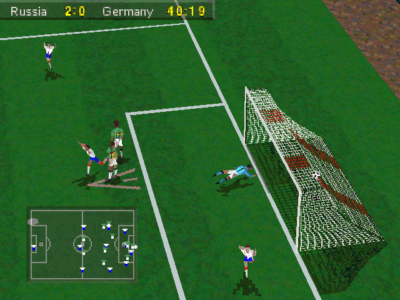
[SVGA] You can choose to play as Germany, of course, and eliminate them as opponents, but then you lose against other good teams. Including, apparently, Russia.
The only other thing to add is that it still doesn’t particularly tally with my memories of World League Soccer ’98 and beyond, which is possibly why I didn’t make the link all those years ago. Otherwise, it’s a fairly standard low-to-mid-table effort which holds the attention for as long as it takes to get the hang of how it all works and achieve a few victories, but without invoking the desire to beat the harder opponents or try and win a tournament.
(In fact…I’ve just realised that we don’t have to merely speculate where football games would rank in an imaginary table of those we’ve covered, for that table is no longer imaginary. So *does quick check* – this is roughly twice as enjoyable as Actua Soccer, but then that’s a low base, making this strictly second division fare.)

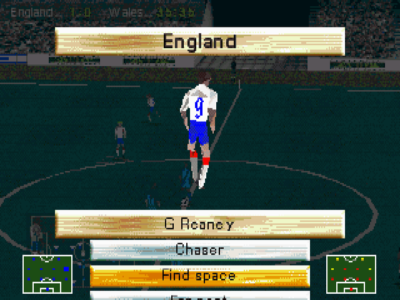
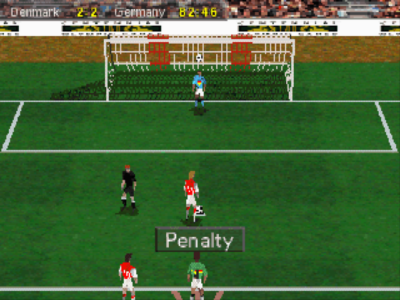
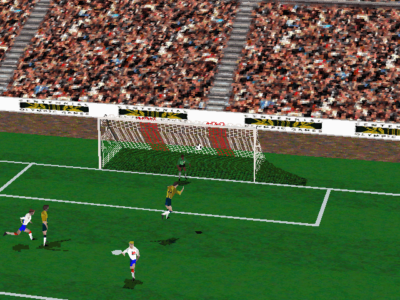

 Posts
Posts
Pediludium[1] est, non legitur. 😉
https://la.wikipedia.org/wiki/Pediludium
September 1, 2019 @ 9:00 am